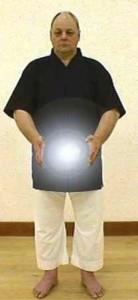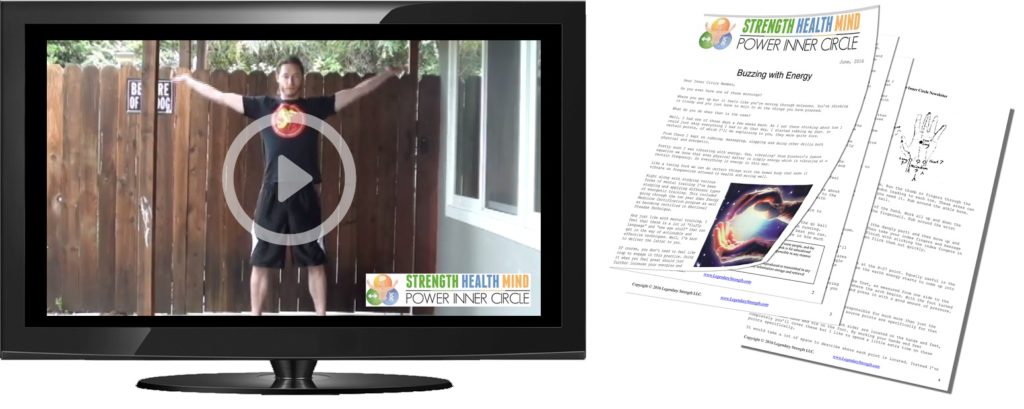I was reading William Pullum’s How to Use a Barbell the other day and came across this quote:
“The things that make for outstanding physical strength are great vital force, a high degree of nervous energy, and superlative quantity of muscular tissue.”
Sounds good to me but what does he mean? The term muscular tissue is clear to just about everyone. But what does he mean by vital force and nervous energy?
As I talk about in Deceptive Strength muscle size can be helpful for strength, but is by no means the only thing, or even the best factor in being strong. Pullum didn’t mark it as such but there seems to be a descending order of importance in the things he listed.
What is Energy?
Because in the “West” there is no real concept of energy like there is in the “East” each person’s reference for these terms is going to be quite different. And if I or someone else is talking about “energy” you may think you understand what they’re saying but you might not. They may not even know what they’re talking about!
We need to get away from nebulous terms like “energy”, or at the very least define what they mean. Its much better to be able to use more specific terms whenever possible.

These people are practicing Tai Chi but how much are they really effecting their energies?
It’s the same thing with Qi (also spelled chi and pronounced as chee). This has been translated to mean energy, vitality or life. In fact many people use the term vital force to describe it. This life energy, vital force or Qi is the difference between being alive and dead. Some would call it the animating force in our body.
Of course, this is all just “woo-woo” stuff and it doesn’t really exist. Only crazy hippies think it does. 😉
Look, I am a very analytical person. (Few people know this but long ago I had plans to become a physicist.) But this energy stuff kept showing up just about everywhere I looked. And after seeing it being used in a variety of ways achieving verifiable results that couldn‘t be explained any other way (some of which you probably wouldn’t even believe me if I told you them) I had to stop resisting and accept energy as a fact. Of course, since then I’ve sought to learn as much as I possibly could about it…
I don’t know if Pullum was familiar with the term Qi at all but he’s saying this vital force is of primary importance in strength. Before we get into more detail on that, lets talk about nervous energy.
Nervous Energy and Strength
Nervous energy and vital force are certainly different. Notice that the term energy is involved here as well. But since its “nervous energy”, it is a more specific form that we can discuss.
Here’s a brief overview of how to nervous system works in the body for anyone curious. (Taken from wikipedia)
The nervous system is the part of an animal’s body that coordinates the voluntary and involuntary actions of the animal and transmits signals between different parts of its body. In most types of animals it consists of two main parts, the central nervous system (CNS) and the peripheral nervous system (PNS).
Neurons have special structures that allow them to send signals rapidly and precisely to other cells. They send these signals in the form of electrochemical waves traveling along thin fibers called axons, which cause chemicals called neurotransmitters to be released at junctions called synapses. A cell that receives a synaptic signal from a neuron may be excited, inhibited, or otherwise modulated. The connections between neurons form neural circuits that generate an organism’s perception of the world and determine its behavior.
At the most basic level, the function of the nervous system is to send signals from one cell to others, or from one part of the body to others. There are multiple ways that a cell can send signals to other cells. One is by releasing chemicals called hormones into the internal circulation, so that they can diffuse to distant sites. In contrast to this “broadcast” mode of signaling, the nervous system provides “point-to-point” signals—neurons project their axons to specific target areas and make synaptic connections with specific target cells. Thus, neural signaling is capable of a much higher level of specificity than hormonal signaling. It is also much faster: the fastest nerve signals travel at speeds that exceed 100 meters per second.

The nervous system is intimately tied into exerting strength and skill.
Nervous energy is talking about the sending of these signals. Although chemicals are involved for the most part its an electric and electromagnetic function of this system, hence the term energy. When it comes to strength it’s the sending of the signal to one or more muscles telling them to contract. This signal will determine how much that muscle contracts and thus the force applied and what exercise or weight you can lift.
If you’re setting up for a heavy deadlift you’re getting your nervous system ready to handle the load. It may not even be done consciously so much but by your lifting a heavy weight you’re mind is telling your nervous system to unleash as much “nervous energy” as it can for the lift.
Several training systems work to optimize the nervous system to send better signals, which would then allow you become stronger.
And of course by doing exercises themselves you’ll get better at them. This has to do with the skill of the movement, which has much to do with the nervous system as well. These nerve pathways become better conductors of the signals the more they are done. This occurs by a process called myelination. Thus the more you practice at something the better your nervous system gets at doing it.
This occurs in everything involving movement. This is also the reason beginners tend to make very fast gains as they go from very uncoordinated in the movements to having some degree of skill in them.
That covers nervous energy. Now let’s move onto the topic of Qi or vital force.
Qi or Vital Force and Strength
To understand this concept its important to realize that there are different forms of energy (once again why the blanket term “energy” isn’t all that useful)
I enjoy this explanation of forms of energy from David Feinstein, PhD.
Healing traditions across cultures and throughout history describe and work with specific energy systems that correspond with the laboratory verifications discussed previously of energies that surround the body, centers where energies converge, and pathways along which energy moves. Many healing practitioners report sensing such energies, which they believe play a vital role in a person’s health. (These healers may possess a quality analogous to synthesthesia, where energies most people do not perceive are registered via their senses, most frequently visually or kinesthetically, but occasionally experienced as smells, sounds, or tastes. Such reports often are corroborated by other healers who are independently recognized for the effectiveness of their methods. These reports, however, also present a challenge to Western models of healing because some of the energies they describe cannot be detected by existing instrumentation. It is also a source of debate whether this is because such energies, assuming they exist, fall along the electromagnetic spectrum but operate in such minute quantities that they do not reach the necessary thresholds for mechanical detection (electrical current can be detected down to 30 quadrillionths, or 1 x 10-15, of an ampere—household current, by comparison, typically carries 15-50 amperes) or whether they are of a fundamentally different nature than electromagnetic energy.
Energy takes many forms—such as kinetic, thermal, chemical, nuclear—but the energies most pertinent to energy medicine seem to involve the body’s (1) electrical energies, (2) electromagnetic energies, and (3) “subtle” energies.
What we discussed in the nervous energy section has to do with electrical and electromagnetic energies. Remember its by those that the nervous system operates.
(I’ve also had lots of fun playing with the electrical system in the body to aid in recovery to jumpstart the CNS and avoid burnout. Very powerful stuff, but a topic for another time.)
Qi or vital force is working on the subtle energy level. According to some research some of these energies are beginning to be measured via better and better instruments.
Just the other week I posted a video of Shaolin monks training and doing a variety of amazing feats. You’ll see them doing various drills in which they’re focusing or moving their Qi to be able to pull off these feats. And once again Qi is a big generalized term. The body has many different subtle energy systems with different roles and qualities.

Feeling energy between your hands is easy. But then what do you do with it?
Saying you need good Qi for strength is like saying you need good organs.
Which organs? In what way?
Which energy? In what way?
Famous strongman and wrestler, George Hackenschmidt knew the truth of this. He stated in The Way to Live, “It has been proved by experiments that thought can influence a livelier rush of blood to certain parts of the body.”
Perhaps you’ve heard that phrase, “Energy flows where intention goes.” Thought can influence energy. This is a large part of why your mental state is such a huge part of being strong. This works on both a nervous and subtle energy level.
Simply running qi into a certain area of the body may help you become stronger to some degree. But there’s so much more that can and will occur with energy.
Different energies in the human body can be disconnected, running backwards, over energized, under energized, blocked, and more.
To cover everything about energy would take many years. But with the foundation of this article I can cover more specifics about using Qi or energy in your strength training endeavors. Please enter any questions and comments below.
Want to feel energy for yourself? Then check out my program Buzzing With Energy.


Comments
Hi Logan, good article. Always interested to see the relationship between Traditional East Asian and Western concepts. You may really enjoy the book: “Restoring Order in Health & Chinese Medicine”. If I recall correctly, the first 80-pages or so define Qi, Yi (intent), and Zhi (willpower), and their relationship to each-other. The rest of the book defines them in Chinese Medicine generally, in acupuncture, and in relation to internal martial arts, especially Taijiquan.
Thanks for the recommendation.
Hi Felix. Where can I get this book? The only link I can find for sale is in either Spanish or Portugese. Here it is: https://www.liebremarzo.com/catalogo/restoring-order-in-health-and-chinese-medicine.
Hi Richard, yes, unfortunately there’s not great demand for these books and they can go out of print! I got it from China Books here in Australia who look like they still have a copy – link below. I’m not sure if they ship internationally, so if not and you don’t have a friend in Australia, feel free to email me at [email protected] and I’d be happy to order it to me and ship it to you.
https://www.chinabooks.com.au/search.cfm?UR=40356&search_stage=details&records_to_display=50&this_book_number=18